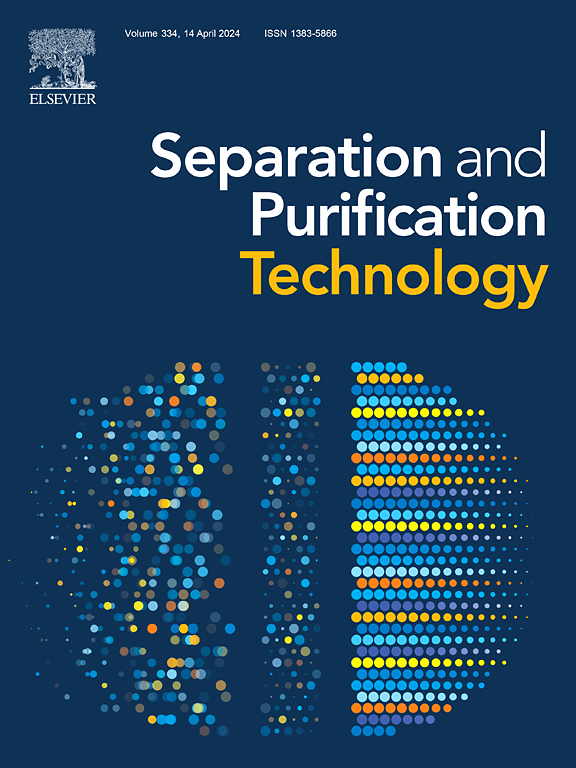cu -生物炭杂化材料对过硫酸氢盐的高效活化:界面电子的来源和转移方向
IF 8.1
1区 工程技术
Q1 ENGINEERING, CHEMICAL
引用次数: 0
摘要
金属-碳杂化材料(MHMs)和氧化剂活性位点之间的电子转移促进了降解有毒有机污染物的活性物质的产生,但其激活机制尚不清楚。通过富铜超富集物热解制备cu -生物炭复合材料(Cu-BC)。Cu-BC表现出优异的过硫酸盐(PDS)活化能力,在可见光照射下,在2 h内实现92 %四环素(TC, 10 mg·L−1)的脱除。空白BC/PDS/Vis体系仅生成·O2 -和1O2的活性氧(ROS)用于TC降解,反应速率常数为kobs = 0.0075 min - 1,而Cu-BC/PDS/Vis体系产生了额外的·SO4 -和·OH,使kobs增加了三倍,达到0.0204 min - 1。清除实验量化了·SO4−和·OH对TC降解的贡献分别为25.5 %和2.3 %。电氧化过程、掩蔽实验和密度泛函理论计算揭示了电子转移过程的重要性。除了来自碳底物的π电子(<17.9 %)外,羰基(C=O)的电子(18.2 %)更有效地转移到Cu- bc表面邻近的≡CuⅡ上。这种被忽略的界面电子转移(IET)使得CuI/CuII/CuIII循环能够将PDS激活到·SO4−,这使得TC的降解率在5次循环后保持在77.1 %以上。在IET工艺中,通过200℃煅烧再生C=O可恢复活性。本研究阐明了碳底物与MHMs表面金属位之间的IET机理,对开发高效MHMs具有重要意义。此外,该系统具有良好的环境适用性和低毒性。本文章由计算机程序翻译,如有差异,请以英文原文为准。
Efficient activation of peroxydisulfate by Cu-biochar hybrid materials: Source and transfer direction of interface electrons
Electron transfer between active sites on metal–carbon hybrid materials (MHMs) and oxidants facilitates the generation of reactive species for degrading toxic organic pollutants, yet the activation mechanism remains unclear. We developed a Cu-biochar composite (Cu-BC) through pyrolysis of Cu-rich hyperaccumulators. Cu-BC demonstrated exceptional peroxydisulfate (PDS) activation capability, achieving 92 % tetracycline (TC, 10 mg·L−1) removal within 2 h under visible light irradiation. In contrast to the blank BC/PDS/Vis system, which generated only reactive oxygen species (ROS) of ·O2– and 1O2 for TC degradation at a reaction rate constant of kobs = 0.0075 min−1, the Cu-BC/PDS/Vis system produced additional ·SO4− and ·OH, leading to a threefold increase in kobs to 0.0204 min−1. Scavenging experiments quantified the contributions of ·SO4− and ·OH to TC degradation at 25.5 % and 2.3 %, respectively. The galvanic oxidation process, masking experiments and density functional theory calculations reveal importance of electron transfer processes. In addition to the π electrons from carbon substrates (<17.9 %), electrons from carbonyl groups (C=O) (18.2 %) are more effectively transferred to adjacent ≡CuⅡ on the Cu-BC surface. This neglected interfacial electron transfer (IET) enables the CuI/CuII/CuIII cycle to activate PDS to ·SO4−, which allows the TC degradation percentage to remain above 77.1 % after 5 cycles. The activity can be restored by regeneration of C=O via calcination (200 ℃) for the IET process. This study clarifies the IET mechanism between carbon substrates and metal sites on the surface of MHMs and is of great significance for developing efficient MHMs. In addition, the system has good environmental applicability and low toxicity.
求助全文
通过发布文献求助,成功后即可免费获取论文全文。
去求助
来源期刊

Separation and Purification Technology
工程技术-工程:化工
CiteScore
14.00
自引率
12.80%
发文量
2347
审稿时长
43 days
期刊介绍:
Separation and Purification Technology is a premier journal committed to sharing innovative methods for separation and purification in chemical and environmental engineering, encompassing both homogeneous solutions and heterogeneous mixtures. Our scope includes the separation and/or purification of liquids, vapors, and gases, as well as carbon capture and separation techniques. However, it's important to note that methods solely intended for analytical purposes are not within the scope of the journal. Additionally, disciplines such as soil science, polymer science, and metallurgy fall outside the purview of Separation and Purification Technology. Join us in advancing the field of separation and purification methods for sustainable solutions in chemical and environmental engineering.
 求助内容:
求助内容: 应助结果提醒方式:
应助结果提醒方式:


